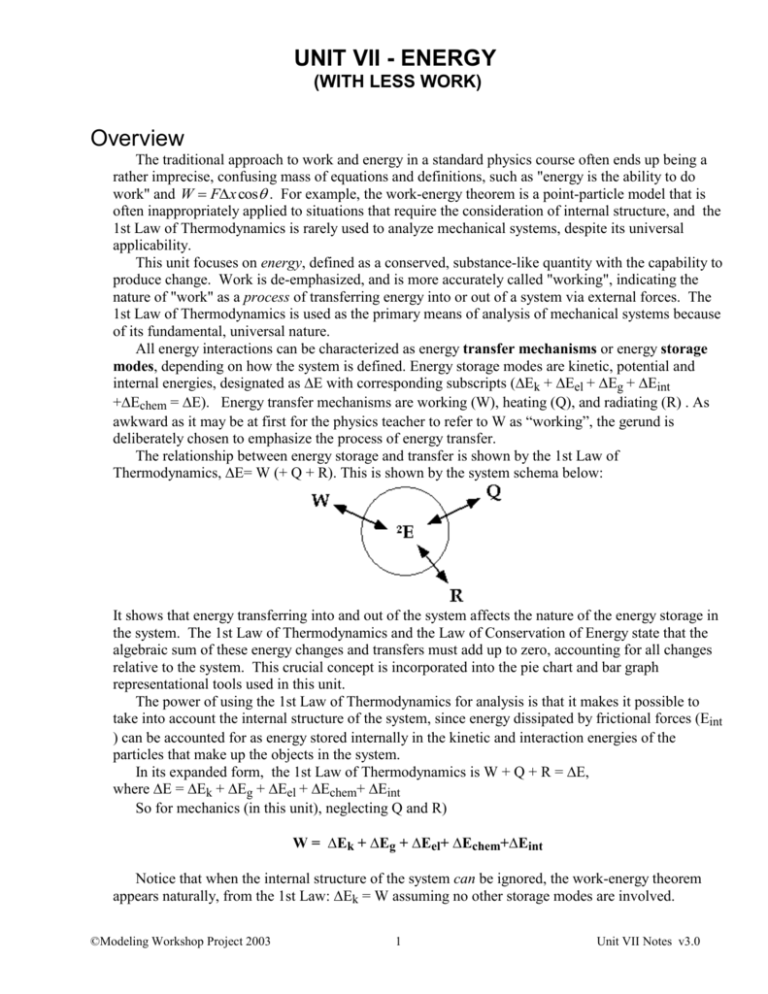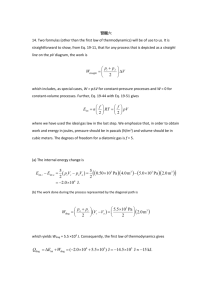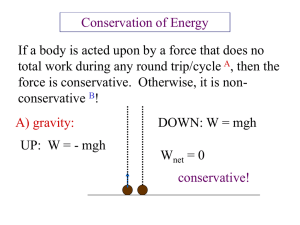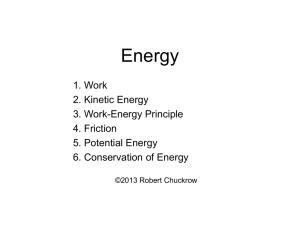N1 - Florida International University
advertisement

UNIT VII - ENERGY (WITH LESS WORK) Overview The traditional approach to work and energy in a standard physics course often ends up being a rather imprecise, confusing mass of equations and definitions, such as "energy is the ability to do work" and W Fx cos . For example, the work-energy theorem is a point-particle model that is often inappropriately applied to situations that require the consideration of internal structure, and the 1st Law of Thermodynamics is rarely used to analyze mechanical systems, despite its universal applicability. This unit focuses on energy, defined as a conserved, substance-like quantity with the capability to produce change. Work is de-emphasized, and is more accurately called "working", indicating the nature of "work" as a process of transferring energy into or out of a system via external forces. The 1st Law of Thermodynamics is used as the primary means of analysis of mechanical systems because of its fundamental, universal nature. All energy interactions can be characterized as energy transfer mechanisms or energy storage modes, depending on how the system is defined. Energy storage modes are kinetic, potential and internal energies, designated as ∆E with corresponding subscripts (∆Ek + ∆Eel + ∆Eg + ∆Eint +∆Echem = ∆E). Energy transfer mechanisms are working (W), heating (Q), and radiating (R) . As awkward as it may be at first for the physics teacher to refer to W as “working”, the gerund is deliberately chosen to emphasize the process of energy transfer. The relationship between energy storage and transfer is shown by the 1st Law of Thermodynamics, ∆E= W (+ Q + R). This is shown by the system schema below: It shows that energy transferring into and out of the system affects the nature of the energy storage in the system. The 1st Law of Thermodynamics and the Law of Conservation of Energy state that the algebraic sum of these energy changes and transfers must add up to zero, accounting for all changes relative to the system. This crucial concept is incorporated into the pie chart and bar graph representational tools used in this unit. The power of using the 1st Law of Thermodynamics for analysis is that it makes it possible to take into account the internal structure of the system, since energy dissipated by frictional forces (Eint ) can be accounted for as energy stored internally in the kinetic and interaction energies of the particles that make up the objects in the system. In its expanded form, the 1st Law of Thermodynamics is W + Q + R = ∆E, where ∆E = ∆Ek + ∆Eg + ∆Eel + ∆Echem+ ∆Eint So for mechanics (in this unit), neglecting Q and R) W = ∆Ek + ∆Eg + ∆Eel+ ∆Echem+∆Eint Notice that when the internal structure of the system can be ignored, the work-energy theorem appears naturally, from the 1st Law: ∆Ek = W assuming no other storage modes are involved. ©Modeling Workshop Project 2003 1 Unit VII Notes v3.0 (∆Eint = 0, if internal structure is ignored.) The work-energy theorem should no longer be used as a generic catch-all equation. It has limited usage because in many situations (frictional systems, and system deformation) its use is conceptually inaccurate since it ignores internal structure. The use of the 1st Law of Thermodynamics is much more comprehensive.2 The concept of "working" is not introduced first. Instead, the idea of energy storage is developed first, by revisiting the Modeling paradigm labs and using energy pie charts to account for all the energy storage modes involved in a given situation. Qualitative Description of Working as Means of Energy Transfer Having established Eel = 1/2kx2 as the quantitative measure of how much energy is stored in the spring, the next natural question is, "Where does this energy come from?” The Eel pies get larger as the spring stretches – what is the source of the increase in energy? A coherent answer to the question depends on how the system is defined. Suppose we define the spring as the system. The added energy is a result of the interaction between an external agent (outside the system) and the spring. The area under an F vs x graph represents the energy transferred during an interaction that results in a displacement of the point of application of the force. When this interaction occurs across a system boundary, we call the process of energy transfer working, W. When the interaction occurs between objects within the system, then we say that the energy is moved from one mode (or account) to another (e.g., from Eg to Ek as an object falls toward the Earth). Such energy transfers affect the energy storage in the system. It is helpful to revisit the money analogy here: energy transfer via working is analogous to depositing a check into the bank (a monetary transfer that results in a corresponding increase in one's savings account (storage). It is important to emphasize that the amount of energy transferred equals the change in energy stored. This will lead into the 1st Law of Thermodynamics and the Conservation of Energy. So, the energy added by the external force on the spring is equal to the energy stored by the spring as a result of the process of working: W = ∆Eel Use the bar graph schema at this point to incorporate the transfer representation. 2 For more details on these conceptual inaccuracies, see Background.doc (Part 3: Justification and Goals…Misconceptions) ©Modeling Workshop Project 2003 2 Unit VII Notes v3.0 Quantifying Gravitational Potential Energy Let's apply these definitions of working to an analysis of gravitational potential energy, Eg. When an object is lifted near the surface of the earth, a force is applied. If the object is lifted at constant velocity, the lifting force, FT, is equal to the weight, mg, for the entire time. When an F-x graph of this process is made, it can be seen that the force applied (FT) is constant. As the object is lifted higher, the area under the graph increases, as does the Eg of the object, due to its position relative to the reference point where h = 0. The area under the graph is rectangular, so W FT h. The lifting force is equal to the weight of the object, mg, since it's moving at constant velocity. So W FT h mgh . Since the energy transferred, W, equals the resulting energy stored, Eg, W = ∆Eg, so ∆Eg = mg∆h; now we have a way to calculate the energy stored this way. Bar graph analysis is also important here: working is done, since the agent exerting the lifting force is external to the system. As a result of the process of working, energy is added to the system, and is stored as Eg. The work done (energy transferred) is equal to the energy stored (Eg), W = ∆Eg. Energy Flow Diagram Initial Ek Eg Ee FT Final E k E g Ee E int box 0 0 W Calculating Energy Transfer due to Working At this point, having firmly established the concepts of energy storage and transfer and the use of representational tools, we can use the standard textbook treatment of "work" to describe quantitatively how energy is transferred by working. Working is defined to be the transfer of energy by an external agent applying a force parallel to the direction of motion, W F|| x . ©Modeling Workshop Project 2003 3 Unit VII Notes v3.0 Accounting for energy dissipated by friction Where the standard textbook treatment of work runs into trouble is in accounting for the energy dissipated by friction. We suggest avoiding statements such as "the work done by friction" since the way we define our system (including the surface), friction is not an external force. Working is done by an external force. If the force of friction is equal to the pushing force, all the energy transferred by working is stored as the internal energy of the constituent particles; there is no change in the other energy storage modes. Thus the kinetic energy remains constant, (∆Ek = 0) since the box is moving at constant velocity. W = ∆E FT x Eint Ek ; since ∆Ek = 0, FT x Eint If, however, the frictional force is less than the external applied force, then ∆Eint is less than W, and some energy also goes to increasing Ek; the box accelerates: FT∆x = ∆Eint + ∆Ek Now is an appropriate time to discuss Eint in greater detail. Where does the energy “not recoverable” go? The key is to recognize that where Eint is involved, the internal structure of the system must be considered. This is especially important in the case of sliding friction in which an interaction between the object and the surface changes the temperature and internal structure of both object and surface – thus, it is most useful to place both in the system. The internal energy is distributed among the kinetic and potential energies of the constituent particles that make up the objects in our system. The most obvious effect is that the temperature of the object(s) in the system increases. However, the potential energy of the individual particles (as determined by their arrangements) can also change. Since these energy storage modes alter the makeup of the system (as opposed to changing the state of the system at large) we assert that internal energy does not leave the system via macroscopic mechanical means. Instead, one must call on heating or radiating as processes that transfer energy from/to the system. A useful example is that of car that slows to a stop. Students recognize that there is something different about the brake pads and rotors immediately after braking. After a while the temperature of these materials returns to normal, as energy is transferred to the surroundings by Q and R. In any event, since we have defined the area under an F-x graph to be energy stored, the area under the Fk-x graph represents the energy stored internally due to friction, so ∆Eint = Fk ∆x. So long as we restrict our discussion of energy transfer into or out of the system via working, then an operational rule could be stated: “Internal energy remains in the system.” Conservative vs. Non-Conservative Forces It is crucial to stress the effect that friction has on energy interactions in the analysis of working; it is important to distinguish between conservative forces and non-conservative forces. The standard treatment of work and energy tends to gloss over this potentially confusing issue. Friction is a nonconservative force because energy transfers are non reversible, whereas gravity is a conservative force because the total change in energy depends only on the difference between the initial and final positions. ©Modeling Workshop Project 2003 4 Unit VII Notes v3.0 Let us first consider the case of lifting an object at constant velocity. [Assume the system is the object and the earth, so the agent providing the lifting force is external, and the gravitational force is an internal interaction]. A lifting force FT is working on an object. As a result of the lifting work, the energy stored as gravitational potential energy increases: W = ∆Eg. No other energies are involved. The amount of energy gained is only a function of the net change in position (displacement). No matter how many times one moves the object up or down, the net increase (or decrease) in Eg depends only on the initial and final positions of the object, not the path followed. One can better understand this statement by considering the signs of the lifting force and the displacement. The applied force is always upwards (+). If the object is moving upwards also (+∆x), the work will be positive (+W), indicating that energy has been added to the system, now stored as Eg. If, however, the object is lowered, FT is still positive, but the displacement is negative, so W = +FT(-∆x). The negative sign on W indicates that energy has been transferred from the system, resulting in a reduction in Eg. Unlike situations in which frictional forces are involved, these transfers of energy into or out of the system with change in direction are reversible. When the object is lowered, energy is removed from the system. But that "loss" can be completely recovered by moving the object back to the original position. There is no energy "lost" to internal storage modes. The final amount of work done will be the sum of all these positive and negative energy changes resulting from the up and down motions. Ultimately the final change in Eg depends only on the object's initial and final positions. This means that if the object is returned to its original position, there has been no net change in the system's energy, and thus no net working has occurred. Because the displacement is 0, the net energy transferred to the system as a result of working is also zero. Hence, we call gravity a conservative force. By contrast, one cannot only consider the final displacement when the situation involves the non-conservative force of friction. Some energy is always going to be stored as internal energy due to the physical interaction at the surface boundaries. The process of working by an external force results in some energy transfer that is NOT recoverable (via working). For example, consider the case where a box is pulled at constant speed through a displacement ∆x, then is pushed back to the starting position. Since friction is involved, some energy is transferred to the system via working in both directions. Even though the displacement is 0, the system has more energy than when it started. In the case of a non-conservative force, the energy of the system always increases, regardless of the direction of motion. Work-Energy Notice there is no specific mention of the work-energy theorem. First of all, it is not necessary to utilize that approach, since an analysis of changes in kinetic energy can be done with the use of the 1st Law of Thermodynamics. Secondly, it is not always conceptually accurate in terms of the energy interactions. The work-energy theorem is only appropriate for situations that do not involve the consideration of the internal structure of the system (no friction involved). As an example, here is how a traditional problem could be set up and solved using the 1st Law: A 70 kg baseball player running at 4 m/s slides into home plate. How far did he slide before stopping, if the coefficient of friction between his clothes and the earth is 0.7? (assuming he didn't run into the catcher or anything else) ©Modeling Workshop Project 2003 5 Unit VII Notes v3.0 Energy analysis: system = runner and earth Initial E: Ek Final E: Eint W = 0 (no external forces) 1st Law: ∆E = W 1/2m∆v2 = f ∆x ∆E = - ∆EK +∆Eint = W = 0 so ∆Ek = ∆Eint - 1/2(70kg)(4m/s)2 = - (0.7)(700N)(∆x) so ∆x= 1.14 m While it may seem like a matter of semantics whether one speaks of "work done by friction" or "energy stored internally due to friction", we think the distinction is important. Arnold Arons argues "In some instances, a quantity that looks like an amount of work done (e.g, f ∆x) but is not real work done by (or against) that force is shown by the COE [Conservation of Energy/1st Law of Thermodynamics] equation to be numerically equal to an amount of real work that was done by some other force (e.g, F) and was dissipated."4 Since we have defined working to be a transfer of energy by an external force, and since friction is not an external force, friction does not do "real" work as we have defined it. 4 A Arons, "Developing the Energy Concepts in Introductory Physics", The Physics Teacher, Oct 1989, p 513. ©Modeling Workshop Project 2003 6 Unit VII Notes v3.0








